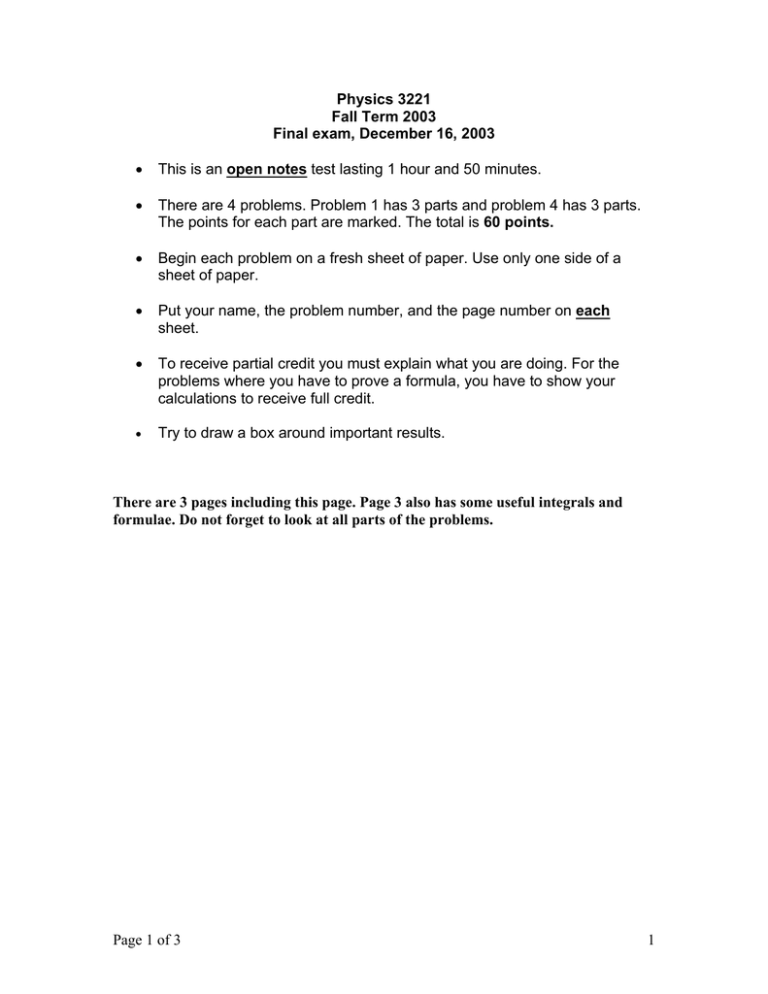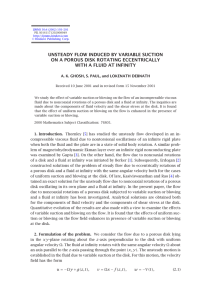open notes 60 points.
advertisement

Physics 3221
Fall Term 2003
Final exam, December 16, 2003
•
This is an open notes test lasting 1 hour and 50 minutes.
•
There are 4 problems. Problem 1 has 3 parts and problem 4 has 3 parts.
The points for each part are marked. The total is 60 points.
•
Begin each problem on a fresh sheet of paper. Use only one side of a
sheet of paper.
•
Put your name, the problem number, and the page number on each
sheet.
•
To receive partial credit you must explain what you are doing. For the
problems where you have to prove a formula, you have to show your
calculations to receive full credit.
•
Try to draw a box around important results.
There are 3 pages including this page. Page 3 also has some useful integrals and
formulae. Do not forget to look at all parts of the problems.
Page 1 of 3
1
1. A driven, damped oscillator has a Q = 6. Recall the velocity vs ω resonance curve for
such an oscillator.
a) Show that β 2 =
ω 02
(5 points)
146
•
b) Find the maximum value of the magnitude of the velocity x in the velocity
•
resonance curve. Let this value be x max
(5 points)
•
c) If ω1 and ω2 are the angular frequencies for which x =
ω1 − ω 2 = 0.166ω 0 ≈
•
x max
ω0
2
, then show that
(10 points)
6
2. Obtain the Fourier series representing the function (half-wave rectifier output):
F(t) =
{
sin ω t,
/
0,
0<t<
π/ω < t < 2π/ω
(Note: when calculating bn, you will encounter a term of the form
Remember that for n=1, this term is of the form
attached on page 3)
sin(1 − n)π
.
1− n
0
. To determine this term refer to tables
0
(15 points)
3. A point mass m is located a distance D from the nearest end of a thin rod of mass M
and length L along the axis of the rod. Find the gravitational force exerted on the point
(10 points)
mass by the rod.
D
m
L
4. A thin disk of mass M and radius R lies in the (x, y)- plane with the z-axis passing
(continued on next page)
through the center of the disk. Calculate:
Page 2 of 3
2
(5 points)
a) the gravitational potential Φ(z) along the z-axis
b) Plot the approximate shape of the Φ(z) on both sides of the disk i.e. for
positive and negative z. Is it symmetric around z=0? Why/why not? (5 points)
c) the gravitational field g (z) = - ∇Φ(z) along the z-axis. (5 points)
TABLES
2 sin A cos B = sin(A + B) + sin(A - B)
2 sin A sin B = cos(A – B) – cos(A + B)
2 cos A cos B = cos(A + B) + cos(A - B)
limit
x→0
sin ax
= a
x
∂Φ ˆ ∂Φ ˆ ∂Φ
∇Φ = iˆ
+ j
+k
∂x
∂y
∂z
Page 3 of 3
3






